This year’s International Manufacturing Technology Show (IMTS) may have now come to a close, but the event served as a valuable meeting point for manufacturers both in and outside of the 3D printing industry.
With the show’s last edition canceled due to COVID-19, IMTS 2022 represented the first time McCormick Place has been able to host 3D printing, machining, injection molding and other production technology developers since 2018. As such, the show offered participants with a long-overdue chance to share new products, strike partnerships and network across industries.
Given the mixture of technologies on show, IMTS also provided a unique opportunity to weigh up the future of 3D printing, and identify where it stands in the wider world of manufacturing. In an effort to find out, 3D Printing Industry covered the event live from the showfloor, and has since reached out to insiders at CONTEXT, the Association For Manufacturing Technology (AMT), Siemens, Carbon and more.
In the view of CONTEXT’s VP of Global Analysis and Research, Chris Connery, “excitement around AM was stronger than ever, with the technology continuing to punch above its weight in terms of media and attendee attention. New additive technologies and companies were showcased alongside industry stalwarts, with companies not a part of the AM industry prior to IMTS, showing their wares and technologies alongside longtime players.”
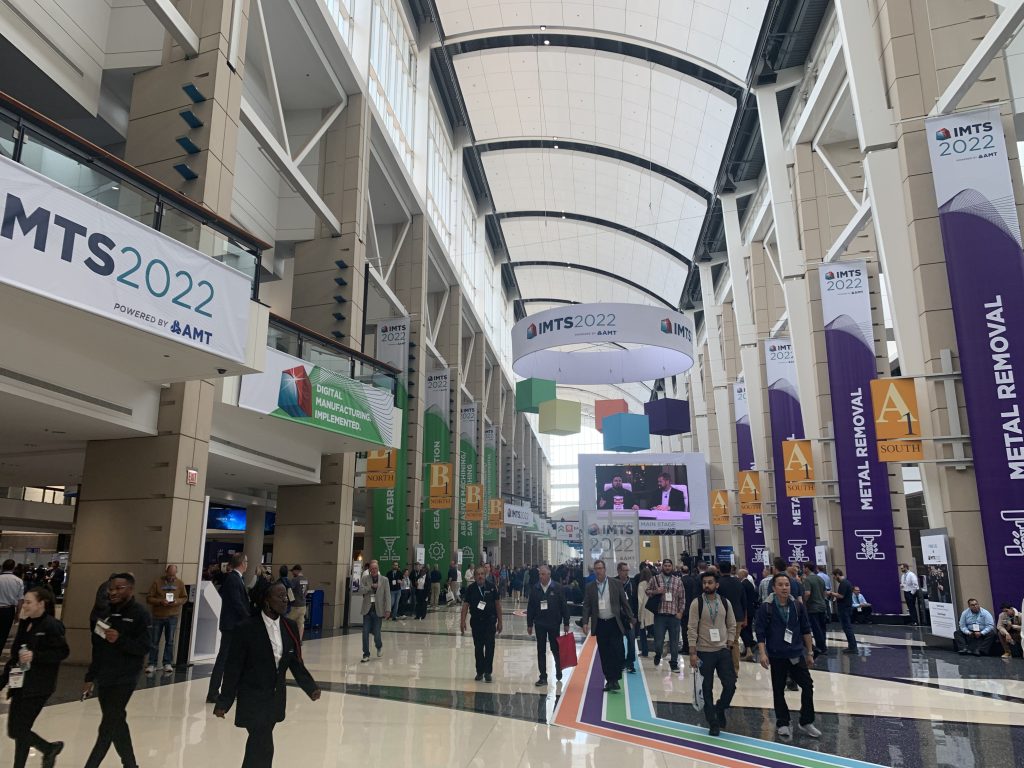
AM’s continued need for speed
According to Siemens Additive Manufacturing Business Manager Tim Bell, the industry is seeing “a significant increase in the use of metal binder jet printing for high volume production.” Bell will no doubt have seen the launch of HP’s Metal Jet S100 3D printer on the event’s opening day. Ahead of the system’s unveiling, the head of HP’s 3D Printing Metals business, Ramon Pastor, said its cost-efficiency would allow it “to drive scale” in binder jetting production.
This throughput drive was also evident across a number of other technologies on the showfloor, including the high-volume Inkbit Vista 3D printer, which began shipping earlier in 2022. At its booth, the firm’s CEO Davide Marini explained how it has developed a “breakthrough algorithm” that allows its machine to achieve a world-record build plate density of 42%.
Marini added that this is also made possible by the inherent benefits of Inkbit’s technology, which allows users to realize prints that combine soft and rigid characteristics, such as manifolds with integrated gaskets or robotic grippers, while “only needing to leave a millimeter’s gap between parts” on the plate.
Elsewhere, at the Nexa3D booth, the firm was debuting its new QLS 820 3D printer, a machine designed to target consistent, high-throughput batches. Mohit Chaudhary, a Senior Applications Engineer at the company, demonstrated during the show how the dashboard system of the printer’s packaged-in software is key to allowing users to “control, regulate and monitor” builds.
Reflecting on IMTS, Dayton Horvath, Director of Emerging Technology and Investments at AMT, identified this as something of an emerging trend. In fact, Horvath believes “operational efficiency and workflow management was exemplified” by software developers at the event, in a way that “complimented the robotics and automation offerings on display.”
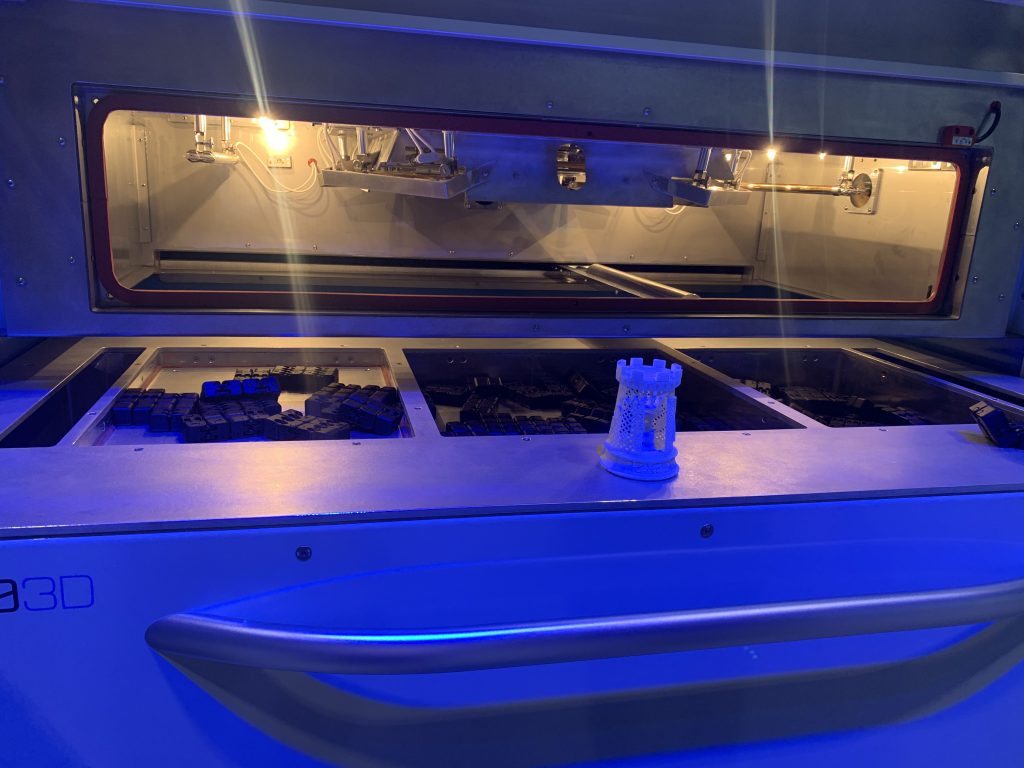
Gaining ground in oil and gas
For his part, Andrew Sink, a Senior Applications Engineer at Carbon, noticed in his IMTS experience how a growing number of firms are taking notice of 3D printing’s “potential to change the supply chain as we know it.” Sink says that businesses are now “recognizing that AM is no longer an offshoot but a mature technology that has a place in their manufacturing toolbox.”
This push towards in-sourcing production was reflected in a growing confidence among 3D printing firms that their products are ready to meet the needs of offshore oil and gas clients. At 3D Systems, the firm showed off Certified CuNi30, a copper nickel alloy developed for Huntington Ingalls Industries subsidiary Newport News, that’s getting a wider launch later this year.
Speaking at the company’s booth, Joe Dopkowski explained how the material’s resistance to salt water corrosion make it ideal for not only producing maritime parts, but those with oil and gas applications. That said, while Dopkowski anticipated there being “a lot of interest” in the alloy there, he added that because there “aren’t any regulations” for 3D printing such parts, potential customers are saying “they don’t know what the implications are.”
In McCormick Place’s East Wing, meanwhile, Oqton CEO Ben Schrauwen outlined plans for his business’ software to make the certification of parts for new industries easier. Using machine learning, the firm’s Manufacturing OS allows users to rapidly optimize print parameters to achieve specific part geometries. At IMTS, Schrauwen boasted that this software allows for the 3D printing of parts with 16° overhangs, on any metal system without changing its hardware.
Moving forwards, Oqton’s Co-founder explained that as there’s so much data in the system, “generating automated certification reports becomes easy.” Unsurprisingly, given that this streamlines manufacturing applications in new areas, he said the software itself was first used in dental, but is now “getting into the energy sector” as well as areas like oil and gas.
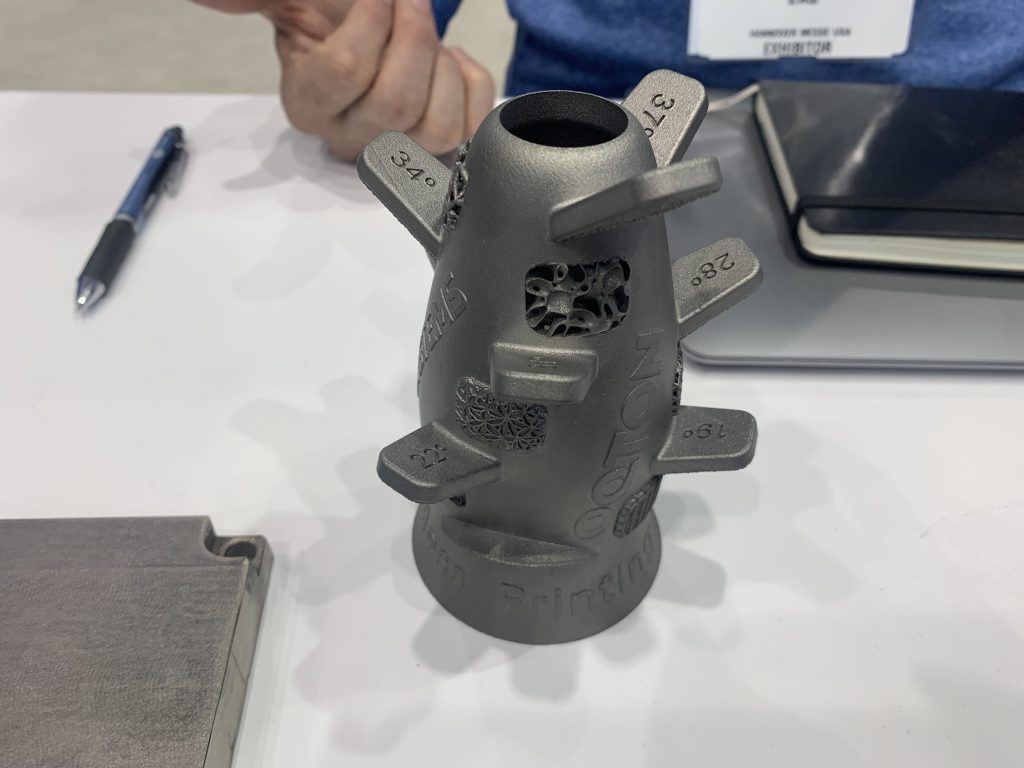
LFAM taking off in aerospace
At IMTS 2022, it was also clear that Large Format Additive Manufacturing or ‘LFAM’ is continuing to gain traction in aerospace. While the Thermwood Corporation’s large-format 3D printing displays have become something of a feature of recent manufacturing trade shows, it did display some interesting new parts.
As well as an experimental mold the firm printed alongside Airtech, it showcased a huge 1,540 lbs trim fixture it 3D printed for Boeing. Produced via Thermwood’s Vertical Print Layer (VLP) system, the 12-foot-long carbon fiber-reinforced part took just over 43 hours to print, and another 40 hours to machine into shape.
Large-format mold 3D printing was also high on the agenda at Ingersoll Machine Tools. Though the firm was exhibiting part of a 23-foot space habitat developed with the Rosenberg Institute and SAGA Space Architects, the team at its booth explained how the nearer-term applications of the Master Print system used to build it, are more likely to be in aerospace mold production.
“So the smaller MasterPrint can be used to print a mold,” the team explained. “Then, you can pick up a milling head to final mill the mold, and if you leave it in place, you can lay carbon fiber over it, leaving a turbine blade for jet planes.” They added that the process, which comes with cost, time and material savings, is set to be adopted by a UK defense contractor later this year.
Due to their secure R&D budgets, Bell says “new manufacturing technologies are pioneered by the aerospace and defense industry.” However, while the Business Manager views this as a positive, he believes it won’t be “until the automotive industry accepts the technology due to its high volumes, that it will become a commodity and experience significant growth.”
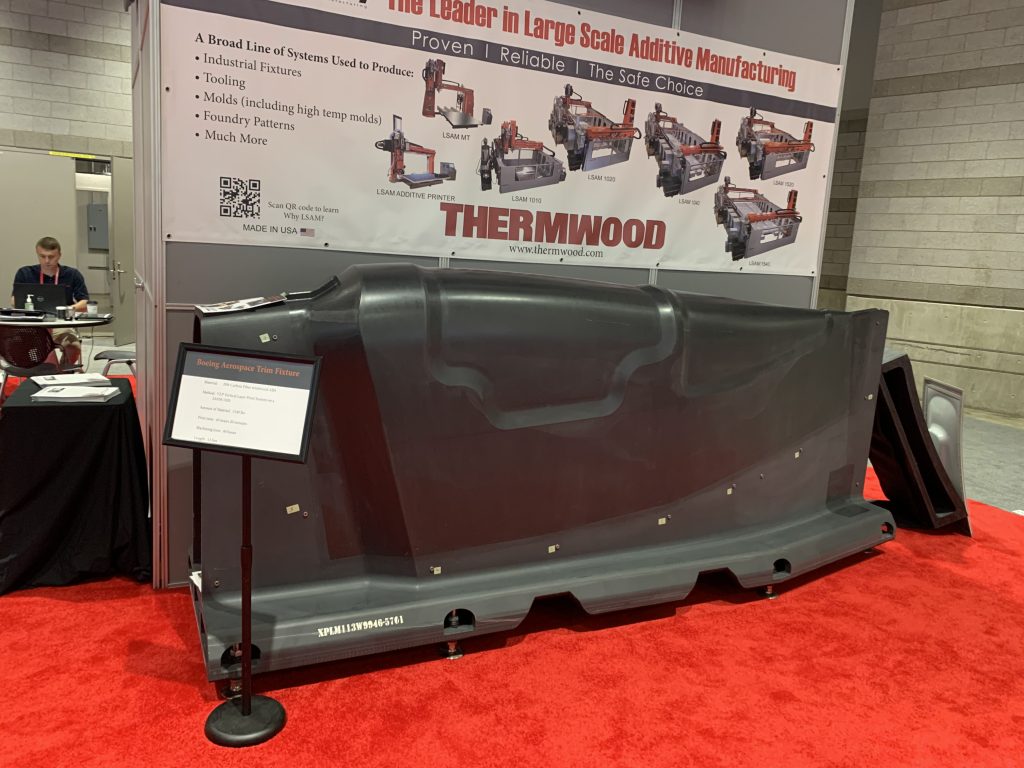
AI-driven geometry optimization
On the software front, Sink says attendees were “eager to unlock the value and opportunity of additive processes by designing specifically for it.” This, the engineer says, was evidenced at IMTS by a shift in thinking around how parts are designed, with many now turning to software tools to improve print performance.
At the booth of Fusion 360 developer Autodesk, Richard Stubley, a Manufacturing Specialist at the firm, explained how this is being borne out in the software’s generative design features, which are increasingly allowing users to “explore the new designs, they’ve never had time to before.”
Stubley said the program makes this possible by suggesting “hundreds of thousands of solutions” based on an inputted design challenge. Using this data, he said, the software then creates a graph, with which adopters can start comparing aspects like “load versus weight versus displacement as a factor of safety.”
“The core benefit is that as a designer, I can concentrate on giving the best solution possible,” explained Stubley. “It allows me to look through a list of predesigns and components to work out actually, these are going to be the best ones. I want to do something different with the way this may have mechanical interfaces.”
Similarly, Dassault Systèmes’ Director of Strategic Business Development, Adrian Wood, claimed that its 3DEXPERIENCE platform now enables users to simulate their way to part stability. As well as optimizing component lightness, he explained how the company’s software allows users “to mitigate risk” by showing them “exactly how it’ll work” once manufactured.
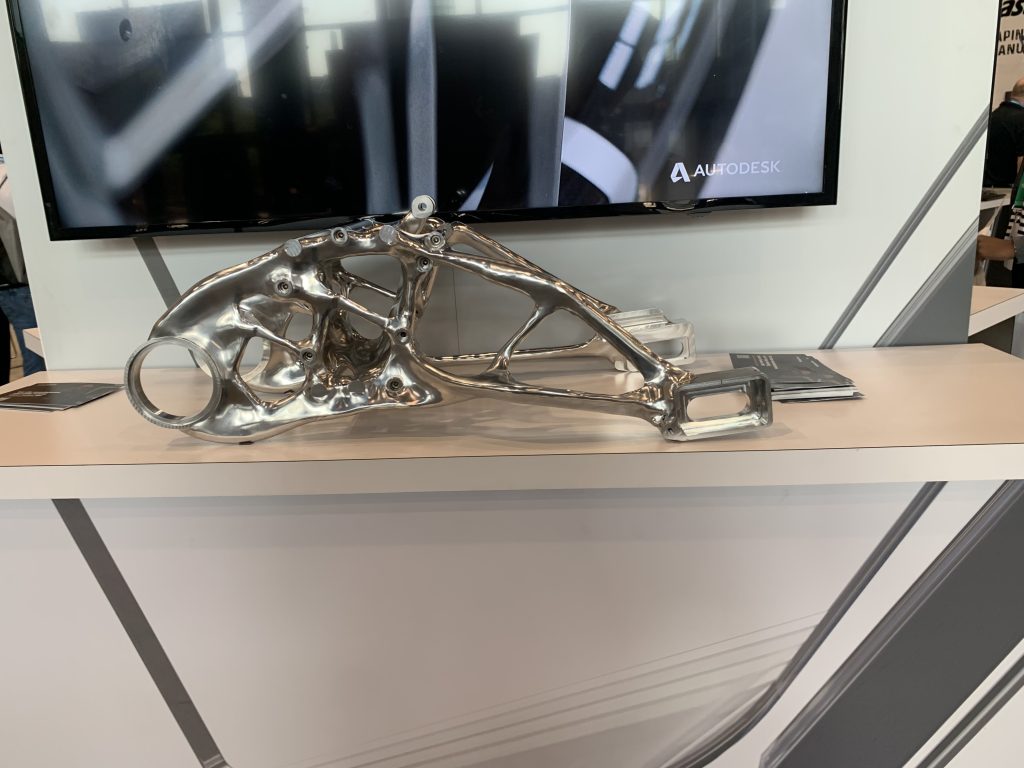
Automation gathers momentum
When it came to trends evident across different processes, Horvath said robotics and automation “were more prevalent, indicating a more complete consideration for the manufacturing process, irrespective of technology.”
In the additive manufacturing pavilion, one of those embracing automation was Optomec, which rolled out the first system developed alongside its Huffman subsidiary, the LENS CS250 3D printer. The automated cell can either be run on its own or chained together to form a production line, capable of both creating parts and conducting repairs on large aerospace builds such as turbine blades.
FormAlloy was another strong proponent of Directed Energy Deposition (DED) automation at the event. During an IMTS presentation, CEO Melanie Lang claimed that “every time that an engineer touches a machine, you’ve lost your repeatability.” To remedy this, FormAlloy has therefore begun focusing on areas like real-time meltpool and off-axis optical monitoring, which enable corrections that keep parts’ layers consistent and properties predictable.
“It’s very important, especially in production, to be able to repeat the same product over and over,” Lang explained during her presentation. “That way, you get the performance and the quality that you need to have a transition into production.”
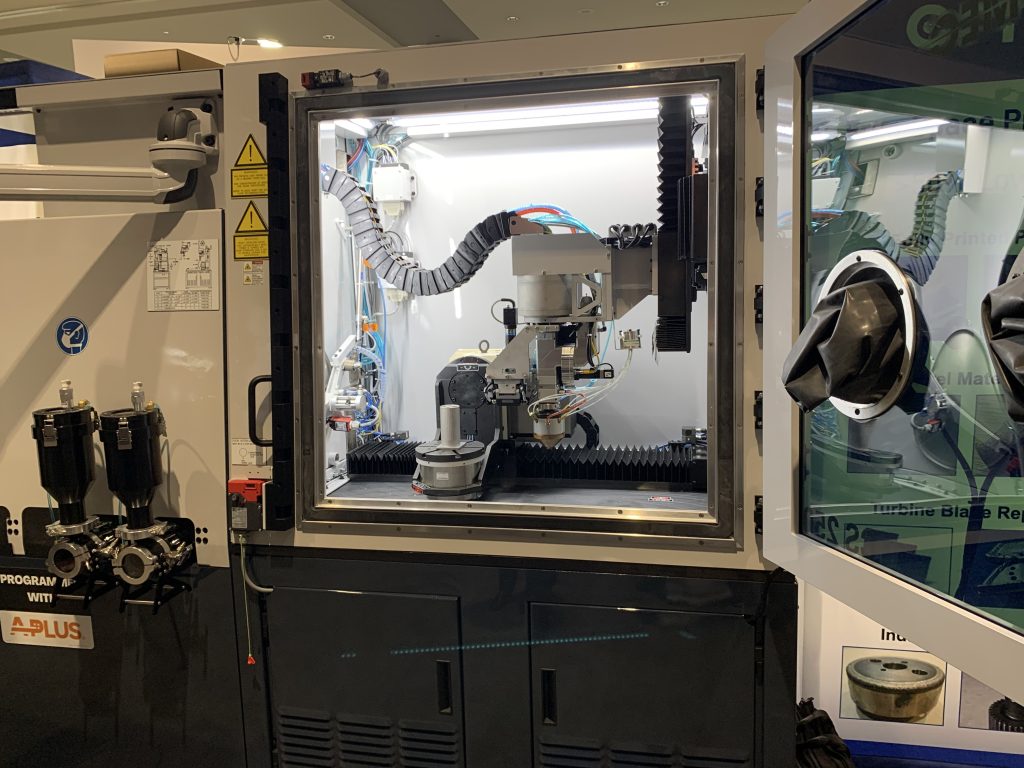
Where does 3D printing stand?
Interestingly, when asked about where 3D printing stood among the other technologies exhibited at IMTS and the direction it might be headed in, each attendee had a different take. While Sink said many at the show were focusing on “consumer applications at scale,” Bell said rising automotive adoption is a sign that “AM is on the path to industrialization.”
Moving forwards, Connery identified binder jetting as “one of the technologies with the highest potential for growth over the next few years.” As well as HP’s Metal Jet launch, the analyst cited the progression of Desktop Metal, Markforged and GE as indicators that shipments of machines powered by the technology would achieve a CAGR of 49% between now and 2027.
Finally, and perhaps most tellingly, Horvath identified how “all the technologies at IMTS were connected,” with two of the five hybrid firms in the AM pavilion combining additive, inspection and subtractive processes. Describing this as “a sign of things to come,” Horvath predicted that the industry will now see “a more connected transition between traditionally separate technologies.”
To stay up to date with the latest 3D printing news, don’t forget to subscribe to the 3D Printing Industry newsletter or follow us on Twitter or liking our page on Facebook.
While you’re here, why not subscribe to our Youtube channel? featuring discussion, debriefs, video shorts and webinar replays.
Are you looking for a job in the additive manufacturing industry? Visit 3D Printing Jobs for a selection of roles in the industry.
Featured image shows McCormick Place during IMTS 2022. Photo by Paul Hanaphy.



